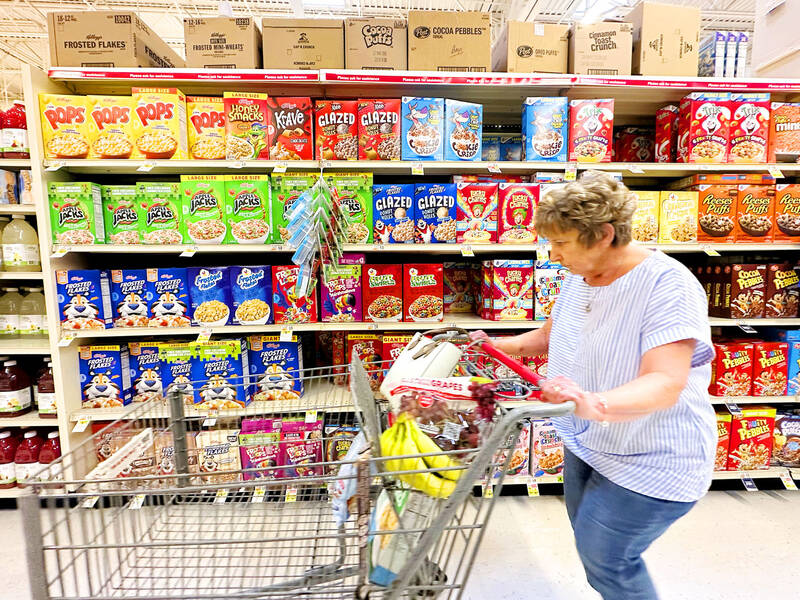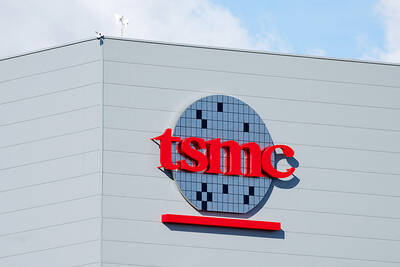Breakfast cereal could use a lucky charm.
US sales of the colorfully packaged morning staple have been in a decades-long decline, a trend back in the spotlight with news that Italian confectioner Ferrero Group plans to purchase WK Kellogg, maker of Corn Flakes, Froot Loops, Rice Krispies and other familiar brands.
Except for a brief period during the COVID-19 pandemic, when many workers were home and had time to sit down with a bowl of cereal and milk, sales of cold cereal have steadily fallen for at least 25 years, experts say.

Photo: AP
In the 52 weeks ending on July 3, 2021, Americans bought nearly 2.5 billion boxes of cereal, data compiled by market research company Nielsen IQ showed, but in the same period this year, the number was down more than 13 percent to 2.1 billion.
Cereal has been struggling for multiple reasons. The rise of more portable options like Nutri-Grain bars and Clif Bars — which both went on sale in the early 1990s — made it easier for consumers to grab breakfast on the go.
Concerns about food processing and sugar intake have also dimmed some consumers’ enthusiasm for cereals. For example, one cup of Lucky Charms contains 24 percent of a consumer’s daily recommended intake of sugar.
“Cereal finds it really hard to get out from underneath that,” said Tom Rees, global insight manager for staple foods at the consulting company Euromonitor. “It can’t escape the fact that it doesn’t look like a natural food. You have to create it and form it.”
For decades, cereal manufacturers focused on adding vitamins and minerals to build cereal’s health credentials, but consumers now are looking for simplified ingredient lists, Rees said.
Artificial dyes — like the petroleum-based colors that brighten Froot Loops — have also come under fire. In fall last year, dozens of people rallied outside WK Kellogg’s Battle Creek, Michigan, headquarters, demanding that it remove artificial dyes from its cereals. Kellogg and General Mills — another major US cereal maker — have since pledged to phase out artificial dyes.
Add to that, consumers are expanding their idea of what breakfast can be. Yogurt and shakes have replaced the traditional bacon and eggs. Polling conducted by market research firm YouGov shows that Generation Z consumers, who were born between 1997 and 2007, eat more vegetables for breakfast than other generations, YouGov vice president Kenton Barello said.
YouGov’s polling also shows that members of Gen Z are less likely to eat breakfast, but still buy ready-to-eat cereal, suggesting they are eating it as a snack or for other meals, he said.
“With younger generations, there are differences in their relationship with food and these eating moments,” Barello said. “They are going about breakfast in a different way than Millennials, Gen X and Baby Boomers.”
Cereal’s struggles are part of what led to the breakup of the Kellogg Company. In 2023, the century-old company that put Battle Creek, Michigan, on the map split into two companies. Kellanova took popular snack brands like Cheez-Its, Pringles and Pop-Tarts, as well as international cereals, and WK Kellogg made cereals for the US, Canada and the Caribbean.
Last year, M&M’s maker Mars Inc announced a plan to buy Kellanova for more than US$30 billion. That plan has cleared US regulators, but is still awaiting regulatory approval in Europe. WK Kellogg was left to try to rejuvenate the cereal business.
The sale of WK Kellogg to Ferrero does not mean supermarket cereal aisles are at risk of extinction. Packaged food companies have options for turning around their soggy cereal sales, Rees said. He thinks Kellogg’s Mashups line, which mixed brands like Frosted Flakes and Froot Loops into one box, appeal to younger consumers, who tend to like interesting flavor combinations.
The market might also have a fragmented future, Rees said. Companies might have to accept that younger buyers want a sweet-and-spicy cereal, while older buyers might want a Keto-friendly option.
“The future might be realizing that the era of ‘This brand will serve everybody’ isn’t going to happen,” Rees said.
Julia Mills, a food analyst with the consulting company Mintel, said the shrinking population of children in the US gives cereal makers the opportunity to shift to more sophisticated flavors and packaging. For example, cereal could be positioned as a fancy topping for yogurt or a fiber-rich food that can improve gut health.
Some niche cereal brands, such as high-fiber Poop Like a Champion cereal and high-protein, zero-sugar Magic Spoon, are already doing that, but legacy brands say they should not be counted out.
General Mills, the maker of cereals such as Cheerios and Cocoa Puffs, considered trying to acquire Magic Spoon, General Mills chairman and chief executive officer Jeffrey Harmening said.
Instead, it made high-protein versions of Cheerios, which now outsell Magic Spoon, he added.
“The key to longer term is, honestly, giving consumers more of what they want,” Harmening said during a conference call with investors in March.

Taiwan Semiconductor Manufacturing Co (TSMC, 台積電) secured a record 70.2 percent share of the global foundry business in the second quarter, up from 67.6 percent the previous quarter, and continued widening its lead over second-placed Samsung Electronics Co, TrendForce Corp (集邦科技) said on Monday. TSMC posted US$30.24 billion in sales in the April-to-June period, up 18.5 percent from the previous quarter, driven by major smartphone customers entering their ramp-up cycle and robust demand for artificial intelligence chips, laptops and PCs, which boosted wafer shipments and average selling prices, TrendForce said in a report. Samsung’s sales also grew in the second quarter, up

LIMITED IMPACT: Investor confidence was likely sustained by its relatively small exposure to the Chinese market, as only less advanced chips are made in Nanjing Taiwan Semiconductor Manufacturing Co (TSMC, 台積電) saw its stock price close steady yesterday in a sign that the loss of the validated end user (VEU) status for its Nanjing, China, fab should have a mild impact on the world’s biggest contract chipmaker financially and technologically. Media reports about the waiver loss sent TSMC down 1.29 percent during the early trading session yesterday, but the stock soon regained strength and ended at NT$1,160, unchanged from Tuesday. Investors’ confidence in TSMC was likely built on its relatively small exposure to the Chinese market, as Chinese customers contributed about 9 percent to TSMC’s revenue last

With this year’s Semicon Taiwan trade show set to kick off on Wednesday, market attention has turned to the mass production of advanced packaging technologies and capacity expansion in Taiwan and the US. With traditional scaling reaching physical limits, heterogeneous integration and packaging technologies have emerged as key solutions. Surging demand for artificial intelligence (AI), high-performance computing (HPC) and high-bandwidth memory (HBM) chips has put technologies such as chip-on-wafer-on-substrate (CoWoS), integrated fan-out (InFO), system on integrated chips (SoIC), 3D IC and fan-out panel-level packaging (FOPLP) at the center of semiconductor innovation, making them a major focus at this year’s trade show, according

DEBUT: The trade show is to feature 17 national pavilions, a new high for the event, including from Canada, Costa Rica, Lithuania, Sweden and Vietnam for the first time The Semicon Taiwan trade show, which opens on Wednesday, is expected to see a new high in the number of exhibitors and visitors from around the world, said its organizer, SEMI, which has described the annual event as the “Olympics of the semiconductor industry.” SEMI, which represents companies in the electronics manufacturing and design supply chain, and touts the annual exhibition as the most influential semiconductor trade show in the world, said more than 1,200 enterprises from 56 countries are to showcase their innovations across more than 4,100 booths, and that the event could attract 100,000 visitors. This year’s event features 17